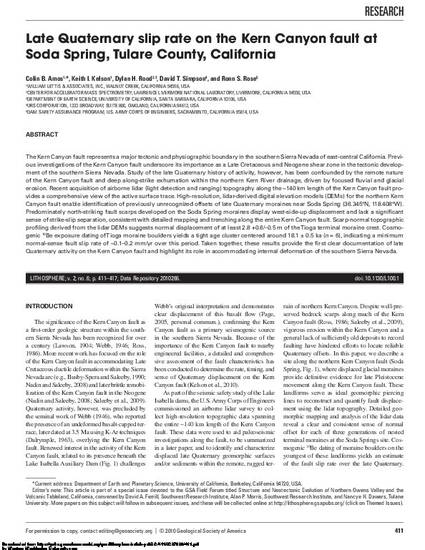
- Alkaline earth metals,
- Kern Canyon fault,
- Neotectonics,
- Geochronology
- Geology and
- Geomorphology
The Kern Canyon fault represents a major tectonic and physiographic boundary in the southern Sierra Nevada of east-central California. Previous investigations of the Kern Canyon fault underscore its importance as a Late Cretaceous and Neogene shear zone in the tectonic development of the southern Sierra Nevada. Study of the late Quaternary history of activity, however, has been confounded by the remote nature of the Kern Canyon fault and deep along-strike exhumation within the northern Kern River drainage, driven by focused fluvial and glacial erosion. Recent acquisition of airborne lidar (light detection and ranging) topography along the ∼140 km length of the Kern Canyon fault provides a comprehensive view of the active surface trace. High-resolution, lidar-derived digital elevation models (DEMs) for the northern Kern Canyon fault enable identification of previously unrecognized offsets of late Quaternary moraines near Soda Spring (36.345°N, 118.408°W). Predominately north-striking fault scarps developed on the Soda Spring moraines display west-side-up displacement and lack a significant sense of strike-slip separation, consistent with detailed mapping and trenching along the entire Kern Canyon fault. Scarp-normal topographic profiling derived from the lidar DEMs suggests normal displacement of at least 2.8 +0.6/–0.5 m of the Tioga terminal moraine crest. Cosmogenic 10Be exposure dating of Tioga moraine boulders yields a tight age cluster centered around 18.1 ± 0.5 ka (n = 6), indicating a minimum normal-sense fault slip rate of ∼0.1–0.2 mm/yr over this period. Taken together, these results provide the first clear documentation of late Quaternary activity on the Kern Canyon fault and highlight its role in accommodating internal deformation of the southern Sierra Nevada.
Available at: http://works.bepress.com/colin-amos/36/
